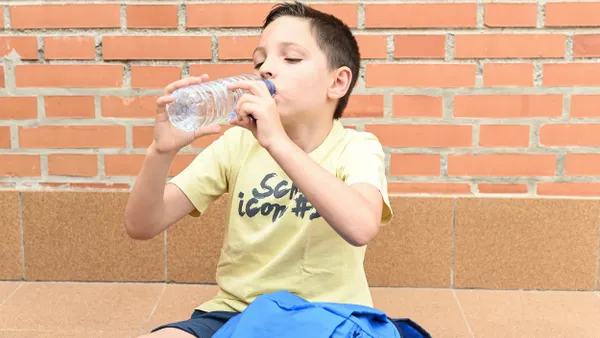As cities grapple with the direct public health consequences of the COVID-19 pandemic, they're also facing the slow build of a longer-lasting crisis: mental health fallout.
In recent years, cities have created new hotlines, substance abuse treatment plans and funding for community care to address rising levels of anxiety and depression. But the mass trauma of the COVID-19 crisis, as well as the looming economic depression, has put even the most prepared cities into overdrive.
New York City’s ThriveNYC, for instance, has seen a significant increase in calls, texts and online chats for its NYC Well crisis support service. Weekly contacts were more than 30% higher in March 2020 than they were in March 2019, although the numbers dropped in April. Web sessions for ThriveNYC (including website visits to browse care options and app downloads) rose from 28,500 in February 2020 to 81,000 in March and 128,293 in April, according to data shared with Smart Cities Dive.
ThriveNYC Director Susan Herman said these increases reflect the complex feelings New Yorkers are experiencing amid the pandemic — and the need for the city to offer a greater source of relief.
"I think that the social isolation and the loneliness and the sadness of the situation, combined with the economic hardship that more and more people are facing, has created enormous distress and mental health challenges that our city is going to need to address,” Herman told Smart Cities Dive. "As a city, we are making sure that not only is access to care a priority, but that we have enough resources to serve those who need it."
According to an April poll from the Yale Program on Climate Change Communication, 54% of Americans worry their mental health has been compromised by COVID-19 concerns, and more than 40% said they feel more anxious, afraid, helpless or overwhelmed than before the pandemic.
Social isolation and loneliness can also be linked to negative mental health, and experts have warned that the extended shutdowns and increased unemployment rates could lead to a rise in substance use.
Cities fill the gap
Even before the crisis, mental health services were strained, with limited public funding and gaps in service. While cities have increasingly offered new treatment options — Denver voters approved a 0.25% sales tax in 2018 to support mental health and substance abuse programs, while the San Francisco City Council approved Mental Health SF in 2019 to guarantee treatment — they will need to play an even bigger role moving forward.
"Cities are the ones who possess the power to address this in a sufficient way," Benjamin Miller, chief strategy officer for the Well Being Trust foundation, told Smart Cities Dive. "Only the local government knows what's best for their residents.”
ThriveNYC was one of the first, and largest, city-led programs to tackle mental health inequities. The $850 million initiative was designed to make sure all New Yorkers, even those without insurance, could get mental health treatment by coordinating with other city departments to prioritize mental health.
In the wake of COVID-19, the initiative has revamped those services, shifting to online and phone-only support. The city has also been updating a list of remote support services, and has adapted its other outreach resources — like counselors in schools and senior centers — to work remotely.
"It's really been quite amazing to see how creative people have been to shift resources to stay in touch with people,” Herman said.
In April, San Francisco Mayor London Breed launched Heal San Francisco, a comprehensive effort to provide mental health support to health care workers, including a customized treatment from the phone-based wellness app Cordico. The initiative is also working with trauma and stress experts to research how to best deliver care to residents.
"The impacts of this pandemic are not limited to the virus itself, which is why these expanded mental health resources are so important," Breed said in a statement.
I'm live now talking with @UCSF's Dr. Joyce Dorado to discuss mental health care and wellness as part of our Heal San Francisco initiative. Tune in here: https://t.co/C5uzIQKscd
— London Breed (@LondonBreed) April 14, 2020
Other cities have taken a role in coordinating and funding community services. Through its ReCAST Minneapolis initiative, the City of Minneapolis' Division of Race & Equity, Minneapolis was already addressing issues of stress and trauma in minority communities. (That program launched in 2016 with a grant from the Department of Health and Human Services to help communities recover from the police-involved shooting of Jamar Clark).
When COVID-19 arrived, ReCAST Program Director Ebony Adedayo said it was obvious that those communities would need additional help. The program responded with a $200,000 Emergency Mental Health Fund for community partners and healers — grants that helped keep some organizations’ doors open.
"Already some of the funding sources were drying up, so we had to respond in the moment," Adedayo told Smart Cities Dive. "We know people of color will be among the hardest hit from any kind of disaster, and we need to make sure the same level of care is available."
Similarly, Caring For Denver, a foundation created after the city's 2018 sales tax increase, has offered guidance to community services as they plan for the coming need. The foundation recently identified two areas where they could fund new programs: one for first responders in the homeless community, and another to support emergency child care for care providers. The foundation does not directly offer counseling, but acts as a coordinator and funder for other efforts. Executive Director Lorez Meinhold said the COVID-19 crisis has highlighted why such a city-run organization is important.
"We have this fund, we have the resources to make sure our communities are equipped to meet the needs, not just during this crisis, but going forward," Meinhold told Smart Cities Dive. "The community informs our funding areas, and those needs will be just as important after this crisis."
Services go online
The crisis has also thrown providers for a loop as they adapt to offering person-to-person care in a remote environment.
Susan Garnett, CEO of My Health My Resources of Tarrant County (MHMR) in Texas, said her organization not only had to purchase laptops and tablets for staff, but also had to figure out how to reach patients who don’t have a stable phone line or internet connection. MHMR, the second-largest behavioral health care provider in the state, also had to coordinate with the City of Fort Worth, TX to create new care options for the city’s homeless population.
"We had to recalibrate at the drop of a hat, and we’re doing this at a time when we didn’t know if we’d get paid for these services," Garnett said. "We had to just do it because we’re here to serve."
County governments have traditionally been linchpins in mental health care by investing approximately $83 billion in health systems annually, and administering 750 behavioral health authorities across 23 states, according to the National Association of Counties (NACo). Yet struggles to move services remotely are also apparent on a county level.
Blaire Bryant, associate legislative director of health at NACo, said agencies have had to purchase new equipment and web services to adapt to remote care, with some spending beyond their budgets to adapt. Others are investing in new projects like public self-care workshops.
Bryant said NACo’s members want more funding and coordination from federal and state governments on how to best treat patients.
"The number one request is coordination among all of the administrative agencies to put together some plan to increase access to services, especially those with substance use disorders," Bryant said. "We will continue to make as much noise as possible about the needs of behavioral health authorities."
The Coronavirus Aid, Relief, and Economic Security (CARES) Act that passed in March included $425 million in mental health and substance abuse funds. Of that, $250 million went to Certified Community Behavioral Health Clinics (CCBHCs), which are backed by Medicaid. Another $50 million was set aside for suicide prevention programs, $100 million for emergency response and $15 million for tribal communities.
While $425 million seems like a hefty number, these funds represent less than 0.3% of the CARES Act's overall public health spending. With limited spending from the federal government through Medicaid and the National Institute of Mental Health, and variable spending across states, cities have increasingly sought their own avenues to boost mental health programs. Seattle and Baton Rouge, LA are among the cities that have increased taxes for mental health programs.
Those citizen-funded efforts can often be more nimble and tailored to specific community needs, especially in reaching underserved and minority communities. They have also emerged as key sources of counseling during this crisis, as cities work to balance the necessary isolation with the side effects of loneliness and anxiety.
They can also help inform decisions across city governments. For example, many cities have elected to keep parks and green space open for mental health benefits. According to a National Recreation and Park Association survey, 83% of respondents said exercising in an open space is essential to maintaining their physical and mental health. Others have actively encouraged residents to contact neighbors and seniors to combat loneliness.
But the limited funding that local mental health services receive could be at risk as city and state budgets dwindle amid the economic crisis, even as the needs are expected to grow.
Meinhold said the pandemic has helped reprioritize the growing mental health crisis, and illustrates how more funding and attention can create better services for patients.
"What the coronavirus has done is spotlighted the existing barriers and shown some new barriers to accessing mental health and substance abuse issues," said Meinhold. "These issues were present prior to COVID and they will stay with us after COVID."
To keep up with all of our coverage on how the new coronavirus is impacting U.S. cities, visit our daily tracker.


















